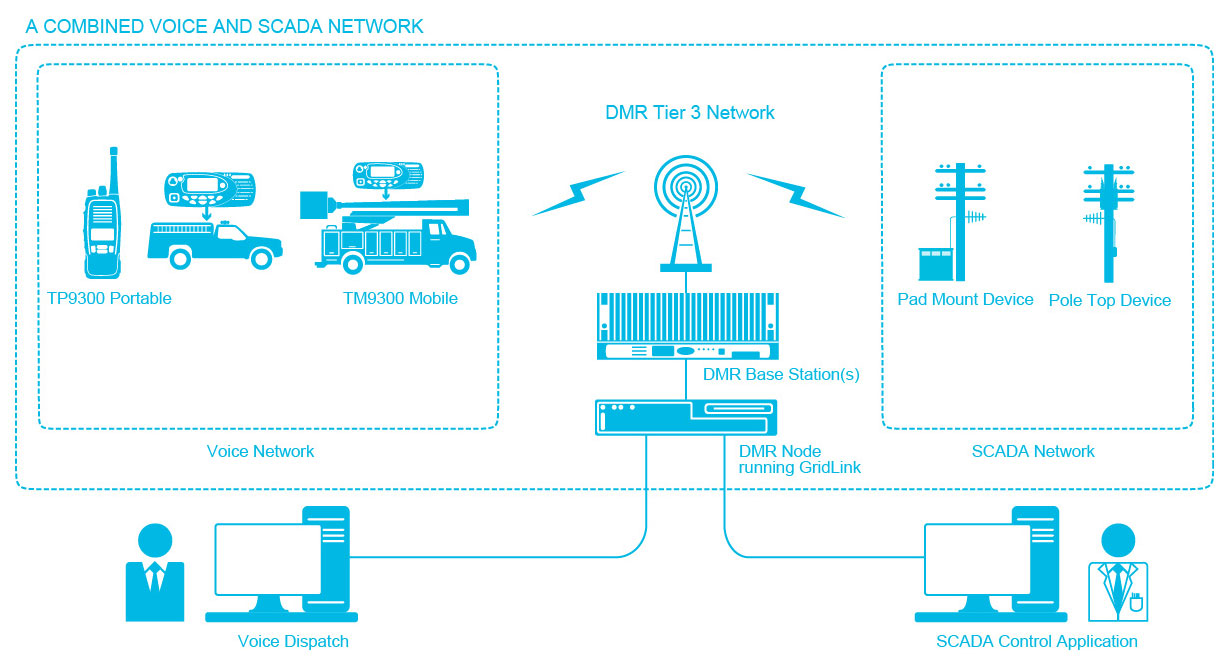Tait GridLink
Andalucian Regional Government - Spain

A Combined Voice and SCADA Network
Tait Gridlink solves both of these problems. This innovative solution utilizes the mission critical, trunked voice and data DMR network. This means it offers excellent and extensive coverage at a very low cost and it is built with resiliency at its core.
With Tait GridLink one mission critical network carries both your workforce voice and grid data. It's the intelligent solution that some of the world's largest networks are choosing.

Business Benefits
One network for voice and SCADA
Traditionally, voice and data communications have been delivered over separate networks. Network managers have accepted this duplication and the associated costs as necessary because of a lack of alternatives and the incremental nature of communication deployments.
The effectiveness of any Distribution Automation solution depends on the reliability of the communications link between devices and the central SCADA system. The intelligence of modern, all digital TDMA-based trunking standards that reliably manage system resources is the key to delivering combined mission critical voice and SCADA networks. At its core, Tait GridLink relies on the Tait DMR Tier III radio platform to provide an extremely reliable and robust communications link delivering market leading critical voice and packet data communications.
The capacity doubling effect of 2-slot TDMA combined with trunking resource management gives network operators new opportunities to:
- Prioritize network resources for voice or SCADA traffic.
- Reserve channel resources for voice or SCADA data so dynamic network loading does not impact the quality of essential services.
- Pre-empt call queues based on call priority and network loading - something DMR Tier II networks or equivalent technologies cannot do.
How does Tait GridLink work?
- SCADA communications are passed from the control application to the Tait GridLink router, located on the DMR Node, and then transmitted via the DMR Base Stations to Tait GridLink terminals at outstation sites.
- Tait GridLink terminals forward the communications to the outstation RTU/IED and await an acknowledgement if appropriate.
- In the event of RF interference or data corruption, the Tait GridLink system will automatically retransmit messages to deliver highly reliable SCADA communications.
- The number of outstation RTUs and associated Tait GridLink SCADA terminals supported by each logical DMR channel is dependent on several factors including number of outstations and frequency of status checks.
- Operator commands are transferred, executed and acknowledged in less than 1.5 seconds under both storm and normal operating conditions.

Improve workforce efficiency with Tait GridLink
LMR systems are essential for Utilities during a disaster, but how do you drive up the value of the investment during business-as-usual conditions?
Ask any Utility network operator what their greatest pain point is and they'll say it is managing operating expenses. Predicting an operating budget a year in advance is difficult enough. Mix in aging infrastructure, severe weather like heat waves or ice storms, and some unplanned maintenance; what you end up with is a fleet of trucks out there day after day, managing the grid, addressing faults, upgrading circuits and gathering performance data.
Consider this:
A typical US electric distribution utility might have 2,000 capacity banks across its operation to compensate for voltage loss associated with warm weather and/or planned state changes. Four times a year, each bank must be manually switched over, by employees in trucks. On average, a truck roll costs a utility $500.
2,000 capacity banks
x four visits annually
x $500 per visit
= US$4million OPEX each year
Imagine converting that $4 million OPEX per annum into CAPEX for infrastructure upgrades, or reinvesting it in the business. Simply by using the data capacity that already exists in a DMR Tier III voice network, these manual switchovers can be managed remotely, from your control centre. Of course this isn't entirely without cost – each capacitor bank would need a data terminal installed to control the switchover. But at around US$1,000 each, the utility in our example will have paid that cost in just two truck rolls. So after just six months, the CAPEX is repaid, and you begin to recoup OPEX.
Better still, you don't need to invest $1,000 on each of those capacity banks all at once. In fact, the business case to tackle the less-accessible banks first is really compelling, as the savings on those truck rolls are greater. By investing first in those banks with the highest savings, you can use those OPEX savings to fund rollout of terminals on other capacitor banks.
This example is premised on $500 per truck roll being the average. Depending on your geography, distance travelled and weather, some of those banks may be costing twice that (or more) for every visit. Conservatively, you might have 10% of your capacitor banks in this category.
Let's take a look at those numbers:
200 hard-to-reach banks
x four visits annually
x $1,000 in truck rolls per year
= US$800,000 OPEX saving annually
200 hard-to-reach banks
x $1,000 data terminal each
= US$200,000 CAPEX investment
US$800,000 OPEX saving
- US$200,000 CAPEX investment
= US$600,000 CAPEX available to invest in 600 further data terminals.
Improved grid reliability and resilience
Delivering power reliably and safely is a constant challenge for electric distribution utilities. The diverse and remote terrains that utilities operate across pose reliability and resilience challenges for their distribution network. Improving their grid visibility and control over their distribution network is a key priority.
Grid managers around the world have leveraged various types of communications to connect distribution line infrastructure and substations to their Supervisory Control and Data Acquisition (SCADA) systems. However, large parts of distribution grids remain invisible to operators and are not monitored or managed due to the challenges of connecting them.
Providing data communication for Distribution Automation (DA) in areas with a low density of pole top and pad mount transformers, reclosers, and capacitor banks is commercially challenging. Fibre optics are generally uneconomic. In rural areas cellular coverage can be too inconsistent, unreliable, and a security risk for mission critical SCADA communications.
Improving electricity grid intelligence with real time centralized monitoring and control of grid assets is now simple and affordable to achieve with wide area radio based DA systems that bring the transformers and reclosers into the central SCADA system.
Tait GridLink employs wide area, trunked digital radio coverage to deliver a DA solution that is highly economic, reliable, and secure. It provides visibility and control of your entire grid. During storms, when trees are laying across the power lines, the ability to detect, isolate, and restore energy around the fault not only saves time and money, it save lives and reduces outage durations.
Tait's world leading Tait GridLink solution is designed to deliver new value to our customers, through secure, reliable, mission critical voice and data services.
Optimize your network and save energy
Tait's unique DMR based Tait GridLink distribution automation system allows you to proactively resolve issues in your network before they escalate into serious problems. Moving from reactive maintenance to proactive maintenance will save you time and keep your network optimized.
Clear visibility of your grid also means you can quickly identify areas where energy is being wasted. You can fix many of these issues remotely, reconfiguring switches to load balance, optimizing Volt/VAR, or more discretely managing feeders, assets and resources. With better grid management, it is easier to ensure that your budgeted asset life cycles are realized and avoid premature equipment failure or replacement.
Beyond usage is the supply of energy, and the changing mix of renewables, the lack of predictability in terms of where they will come into the system or when. If managing the grid was difficult before, it will be nearly impossible without greater visibility and control. The Tait GridLink solution can enable the dispatching of renewables, or the disconnection when they introduce instability. As long as these energy assets are deployed within the DMR Tier III coverage area, Tait GridLink can help you affordably integrate, monitor, and protect the system from distributed energy resources.
In the future, utilities will need to adapt to even more dynamic energy resources. Consider that an electric vehicle could supply energy to the grid as easily as it can recharge from it, or the fact that the batteries that power electric vehicles will one day power energy storage devices for industrial, commercial, and residential consumers.
Balancing the load and the energy from distributed resources will require reliable, wide area communications that provide continuous grid visibility and control to operators. With the right balance, the energy system can optimize, eliminate peaks, and reduce the cost while increasing the reliability of energy for generations to come.
Tait GridLink in the News
%20for%20Whats%20New%2c%20Discover%2c%20Bottom%20Cards%20Listing/Case%20Studies/Enel-440x270.jpg?width=300&name=Enel-440x270.jpg)

%20for%20Whats%20New%2c%20Discover%2c%20Bottom%20Cards%20Listing/Case%20Studies/Talquin-440x270.jpg?width=300&name=Talquin-440x270.jpg)
Discover more about Tait GridLink
%20for%20Whats%20New,%20Discover,%20Bottom%20Cards%20Listing/Case%20Studies/EA-network-440x270.jpg?width=440&height=270&name=EA-network-440x270.jpg) EA Networks, New Zealand
EA Networks, New Zealand
EA Networks owns and operates the electricity distribution network and an advanced fiber-optic communications network for the mid-Canterbury region, delivering power to approximately 17,450 consumers through almost 1,864 miles (3,000km) of distribution lines.
%20for%20Whats%20New,%20Discover,%20Bottom%20Cards%20Listing/Case%20Studies/Enel-440x270.jpg?width=440&height=270&name=Enel-440x270.jpg) ENEL/ENDESA, Spain
ENEL/ENDESA, Spain
The Enel Group is made up of nearly 70,000 people from around the world whose work is based on core values of Responsibility, Innovation, Trust and Proactivity. Tait proposed DMR Tier 3, a market-leading, open standards based 12.5khz communications solution.
%20for%20Whats%20New,%20Discover,%20Bottom%20Cards%20Listing/Blog/Solutions-for-Utilities-440x270.jpg?width=440&height=270&name=Solutions-for-Utilities-440x270.jpg)